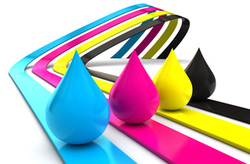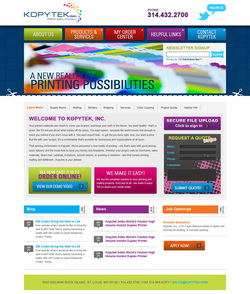 Do you know the difference between digital printing and traditional methods? In digital print processes, no printing plates are used. As a result, digital products are produced more quickly and affordably; however, they also tend to cause a loss of detail. Digital prints are commonly seen in inkjet and laser printers.As a result of the push for cheaper, faster methods digital printing has seen an increase in recent years. Approximately 9% of the world's printing is digital, and that number is expected to increase. Clearly, the advancing technology has become an important part of the print industry. For more information about digital and traditional printing, click here.
There are many types of printing processes. We will cover a new printing process every week as we look into the intricacies of printing and how important the invention and innovations of it have changed our society.
Around 220 AD, the woodblock printing process was developed by Eastern Asia. This process consisted of a printer carving designs, images and text on the surface of a block of wood. The niches created would produce white space on the textile or papyrus, causing noticeable differences in its look - very much like how a stamp works. This process evolved into many other forms of printing such as block printing and moveable type printing. The dilemma that faced printers was the fact that woodblock prints were mirror images of the carvings on the block. This meant that carvers had to etch their designs into the wood in reverse of itself. For example, if I wanted to carver a B, I would have to etch it in backwards.
Moveable type printing was developed by Bi Sheng of China. This process was developed on the basis that individual text, image and design stamps would produce a more efficient print in both time and quality - creating more in less time. This was important because woodblock printing took a massive amount of time to carve pieces of wood and put together prints that were acceptable. Moveable type eventually led to the invention of an efficient printing press by Johannes Gutenberg.
Simply put, the advances and evolution in modern digital printing provides a diverse mix of products and solutions for the forward-thinking business. From signs, banners, and advertising to presentations, brochures, and flyers- digital printing provides high-quality, eye-catching collateral at prices previous unheard of. We've discussed many of the key advantages in technology previously, but for today I want to focus primarily on the convenience and flexibility offered with the current products. I'm sure at one time or another, many businesses have found their backs against the wall- forced to make emergency changes at the 11th hour when Murphy's Law rears its ugly head. Perhaps the printers are down at the office.. Maybe your former printing company is closed for the night.. the chances of getting the amended project finished in time slowly go from slim to none. In past years; that key account, the big presentation, the important visual aides may all be lost for good- but that no longer has to be the case.
Many digital printing establishments now offer 24/7 online submissions, easily uploading the information from any computer into the company's online database. You can choose from a variety of products and designs, ensuring the material your business worked so hard to create is finished to your exact specifications. In addition to the monetary savings compared to 'expedited/rush orders' in the past, many projects can be completed with less than a 24-hour turnaround time! Suddenly, all that may have seemed hopeless can be salvaged. The new technologies, combined with knowledgeable companies at the helm, are true assets to help your business grow.

If you're a business out there, you know how difficult of a task it can be to get something done and get it done right. Printing is no exception. If you host seminars, meetings, consulting, etc., printing brochures, packets and important documents are beyond important to the health of your company. These documents are what keep it running! So, what do you do and who do you go to? Oppositely, as a printing company in St. Louis, you are faced with multiple scenarios when printing off brochures, packets and important documents for a local company that is dependent upon them - perfection. How do you reach it? Whether or not you are on the receiving or printing end of business, getting good, affordable digital copy is a hassle and the complications that could occur vary in many degrees. For example, if you are printing an order for a business you have to make sure that you take care of the pre-printing stages with perfection in mind. Taking note of the correct card stock, the number of prints (taking into account margin for error), font color, background color, layout, and paper size are a few of the pre-printing steps. After printing, your client may need additional services such as laminating, binding, and so on... On the other hand, if you are on the receiving end of things then you are faced with the printing company messing all of these steps up. Imagine you are giving a presentation to a client who is expecting you to knock them of their feet, and then the printing company you used fails to deliver a high quality product that results in your client being less than thrilled. So, next time you require printing - make sure you find the right team out there that will put you first!
They say print advertising is dead.
Newspapers are disappearing and losing circulation annually. Magazines are depleting, with existing magazine issues losing circulation annually. All the news media seems to shift their focus online. Social media is growing millions of users annually. Even retail advertising starting to focus more online than in the newspaper.
Print advertising is dying, but it’s not dead. I don’t believe it for one second.
On the contrary, print advertising has never been more advanced or more innovative.
For one thing, digital printing has been growing in popularity and technological innovation every year. Digital printing is a printing process that prints anything from a computer with any and all colors, on demand, on a particular paper size. No printing plates needed! Digital printing is mainstream - you may have an inkjet or laser printer at home, but digital printers that businesses use have been growing in numbers and innovation. The printers are larger and can handle more paper with less ink. Printing can be rapid-fire fast or printing at a slower, steady pace that produces colors that are works of art.
I mentioned earlier that digital printing does not use printing plates. Printing plates - each plate being one color of the design - would have to be individually created. All the inks would work together with each printed plate to create one multi-colored image. It’s very common in screen printing, where a squid-like machine has outward “tentacles,” each one being a design specified for one color ink. To produce a poster that used to require screen printing, all the colors can now be printed at the same time in one process.
Thanks to the innovations from digital printing, direct mail advertising has been growing annually, and has been using the popular digital printing processes to reduce costs. Digital printing would also speed up the processes necessary to print, meaning the communications messages are more accurate and are delivered much quicker now than 20 years ago.
What other medium of communications shows up right to your door every single day? Other than interpersonal communication, what other form of communication knows you? Companies can send bulk mail printing to specified households that have specified interests in mind. No two communities that receive bulk mail receive the same exact bulk mail, as each town block can have its own set of mail with the intention of targeted advertising.
Print advertising, in our blogging, social media Web 2.0 age, is in fact more essential than ever. Creating print communications for potential clients gives them a physical, tangible object that stays with them for a longer period of time. Online advertising is usually ignored & clicked away. Print advertising is a tangible piece of paper held & touched by the individual, who can see the message with their very own eyes, and then either hold or dispose of the print advertising. In other words, print advertising provides a longer period of initial exposure and repeated impressions than online advertising.
So when you’re deciding how to express your communications messages from your business to the public, don’t count out print advertising as part of your marketing budget. Its versatility, evolving innovation, and pin-point accurate target marketing can deliver your messages to your desired audience more effectively than advertising online.
|


 RSS Feed
RSS Feed